Learn how to make lime marmalade with this easy recipe, which makes a small batch from whole limes, sugar, and lemon juice, without adding any commercial pectin.
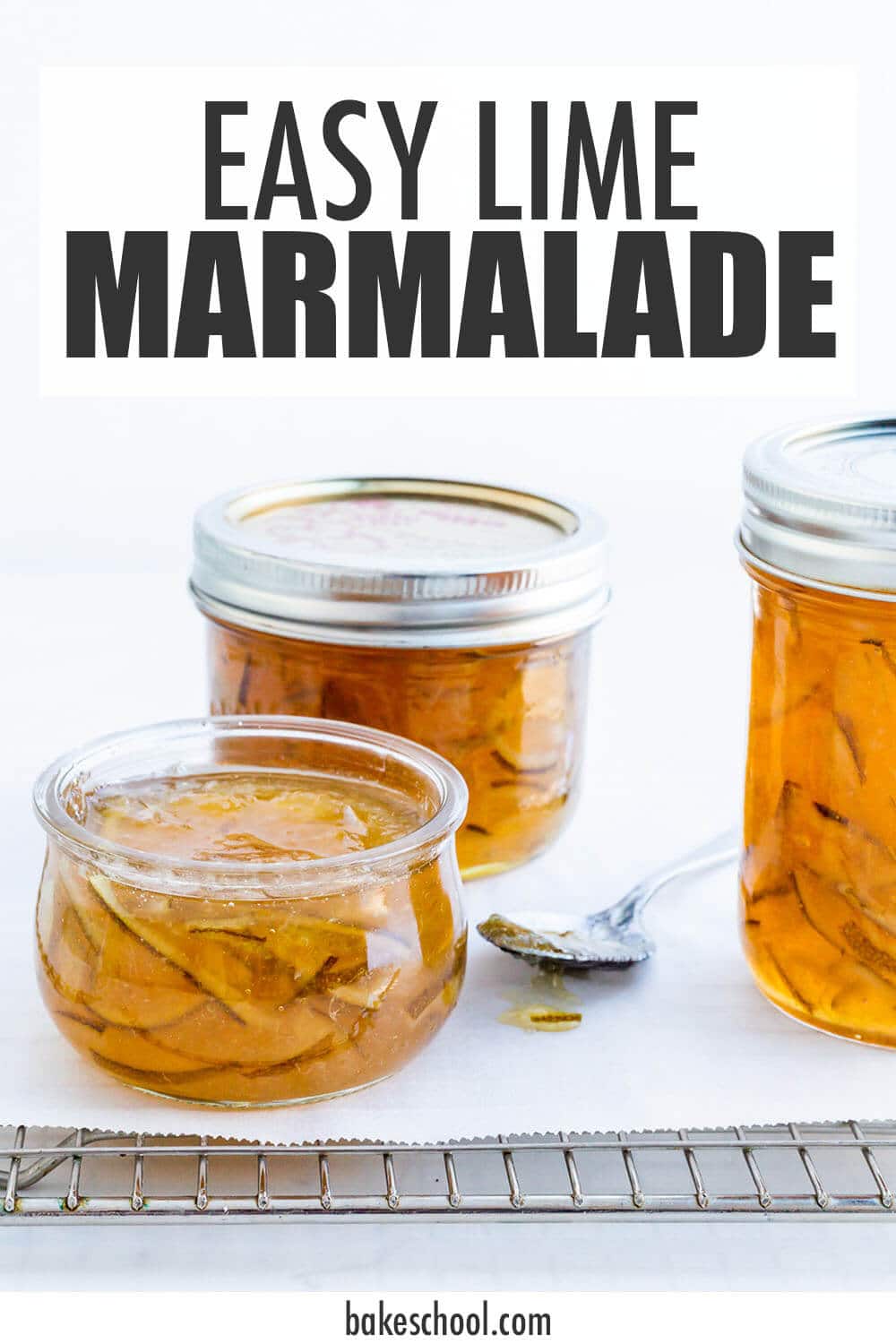
Taking advantage of citrus season is one of the best ways to beat the winter blues, and making marmalade is a fun weekend activity that is so rewarding, especially considering that it's minimal effort. Yes, there are a lot of steps, but there's nothing too complicated:
- Boil the sliced citrus limes in a large pot of water, until they are very tender and soft, for over an hour.
- Combine the softened sliced limes with sugar and lemon juice.
- Boil the lime marmalade to 219–220 ºF (104–105 ºC). This is the ideal setting temperature for marmalade based on my tests.
- Transfer the marmalade to clean jars to seal them using either the water bath method or by inverting the jars for 2 minutes.
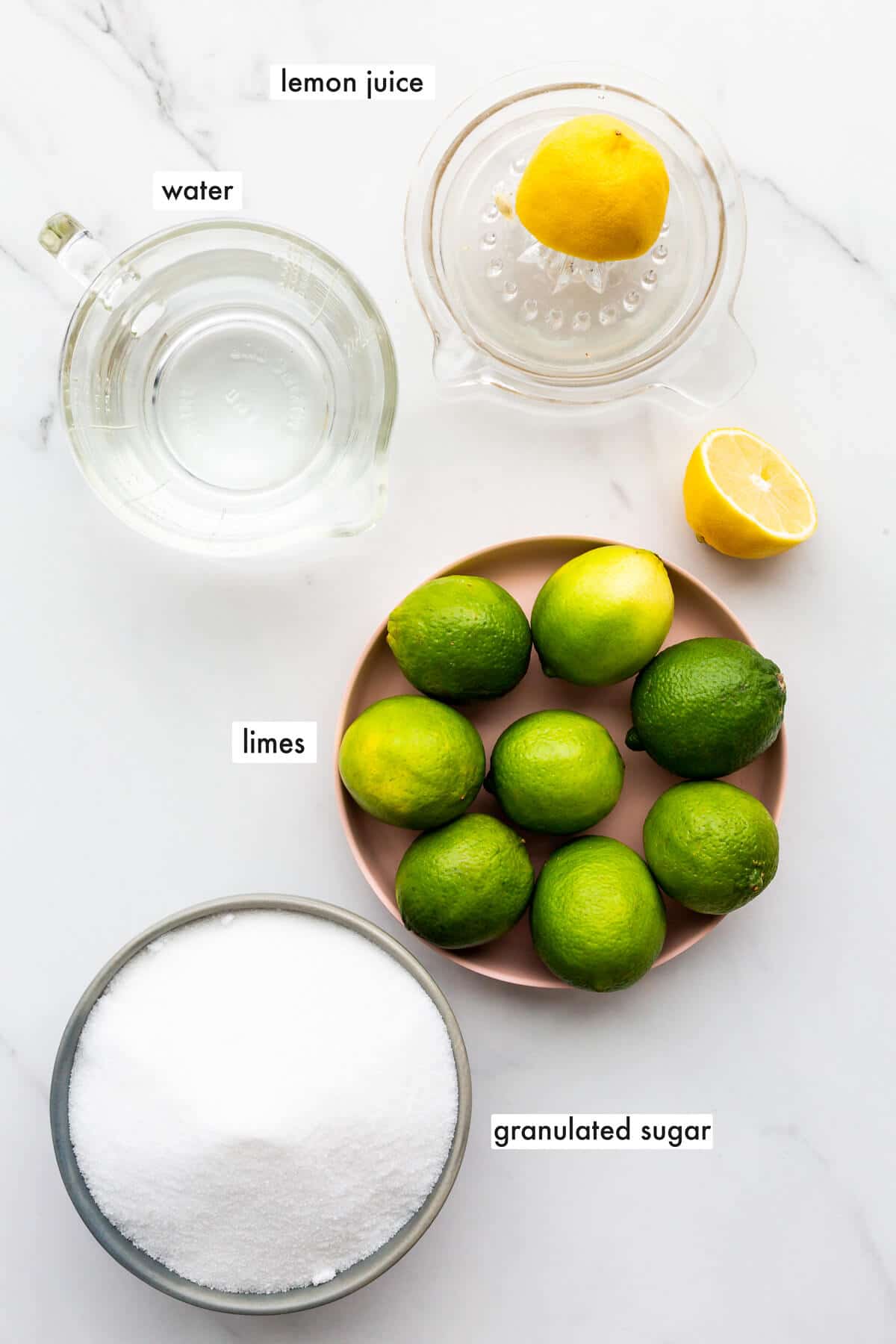
If you've never made it and aren't familiar with making preserves at home please read about how to make marmalade and the marmalade setting point before proceeding!
Jump to:
What you need to make this marmalade recipe
The best way to make lime marmalade is with the whole fruit because it's simple to do and doesn't require any added pectin. All you need are:
- whole limes, washed and scrubbed well
- water—tap water is fine: if you can drink it, then you can make marmalade with it
- sugar—granulated or special fine sugar works great here, and you don't need to invest in superfine sugar, which is more expensive. Superfine sugar will dissolve faster than regular granulated sugar, but the results will be the same!
- lemon juice—I prefer the taste of freshly squeezed lemon juice, as opposed to the bottled kind, and since the recipe already has a lot of acid present, you don't need to worry about the pH
Do not use jam sugar, also called gelling sugar, for this recipe. Jam sugar actually combines fine sugar with pectin and an acid (like citric acid) to promote gelling and set when making jams, marmalades, and sugar-based preserves. You do not need extra pectin for this and the other marmalade recipes on this site so please use regular granulated or fine sugar for this recipe!
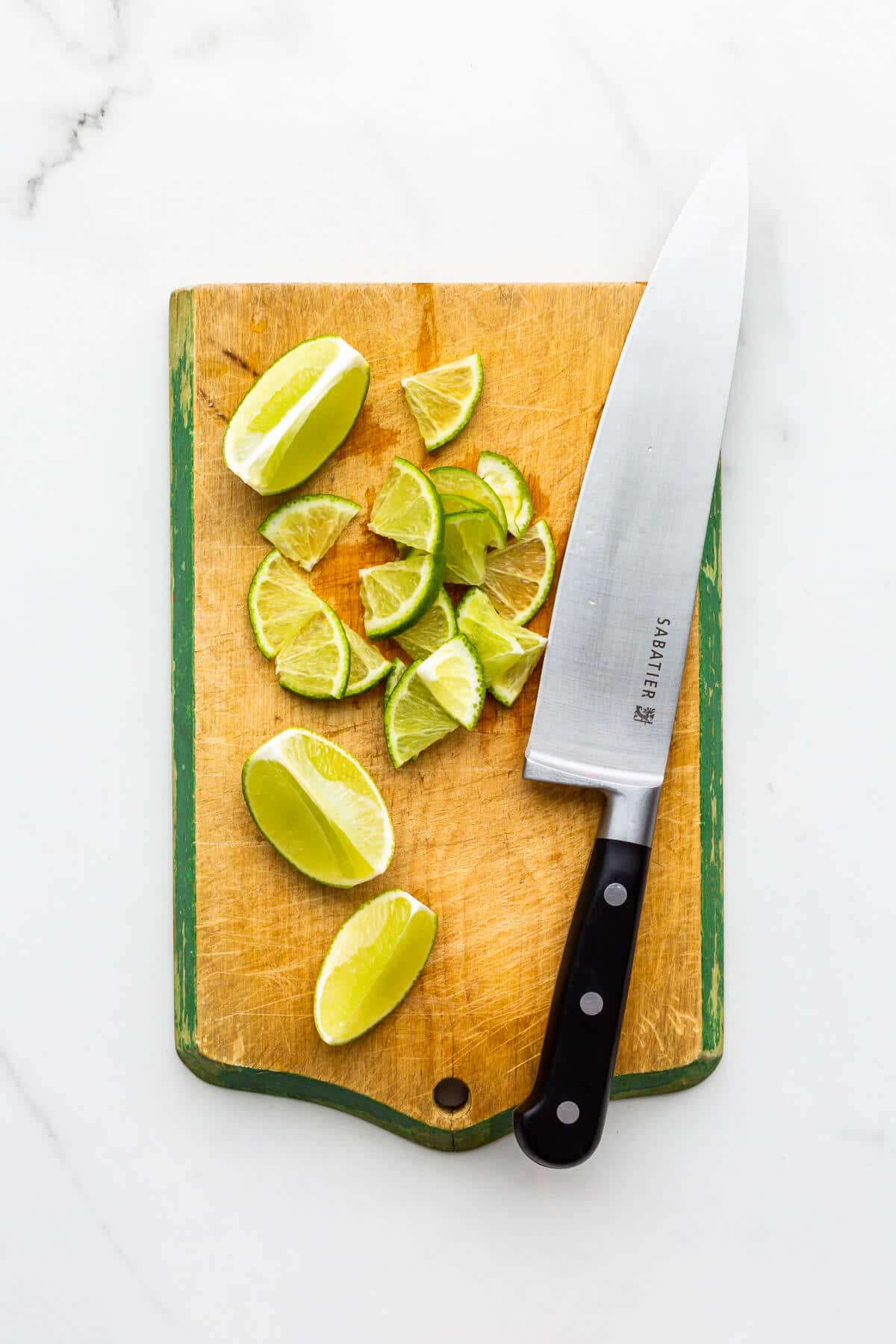
Types of limes
For this recipe, we are using standard grocery store limes. The variety is Persian or Tahitian limes, at least in North America. They are seedless and not too small, which makes them very easy to handle. These limes are sour with bitter notes.
You could also try this recipe with key limes, also known as Mexican limes. Use the same weight of fruit as suggested in the ingredients for this recipe, so use 650 grams of key limes to make key lime marmalade. Note that key limes have seeds, so you will have to remove them as you slice the fruit. Since key limes are sweeter, you may reduce the sugar slightly. The minimum would be to use a 1:1 ratio of key limes to sugar by weight.
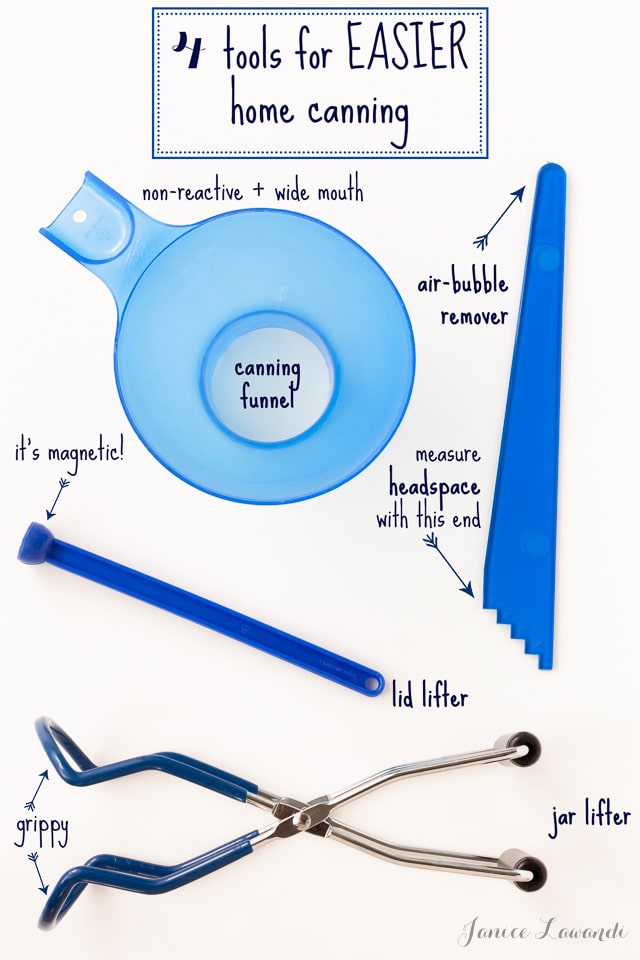
Special equipment
Surprisingly, you actually don't need anything special to make marmalade at home from scratch. You will need:
- a knife and cutting board to slice the fruit
- a big heavy-bottomed pot
- a wooden spoon or a heatproof silicone spatula
- canning jars and lids (always use new lids to ensure the rubber seal isn't damaged)
- a canning kit—you can read all about the components of a home canning kit but usually they come with a non-reactive funnel, a gauge for measuring the headspace between the surface of preserves and the lip of the jar, an air bubble remover, and a magnet for easily picking up the lids
- a digital thermometer, like a Thermapen or hands-free ChefAlarm, a fast-reading, accurate thermometers recommended for home cooks and bakers
Cookbooks on Preserves
If you are interested in simple recipes and techniques for making preserves, like this marmalade, check out Camilla Wynne's books on preserving:
- Preservation Society Home Preserves, covering all forms of preserves from jams and marmalades to pickles and savoury preserves
- Jam Bakes (available on Amazon), which is dedicated to making preserves and baking with them too!
I used both these books to research this recipe and follow Camilla Wynne's methods closely as she taught me how to make Seville orange marmalade years ago. Highly recommend!
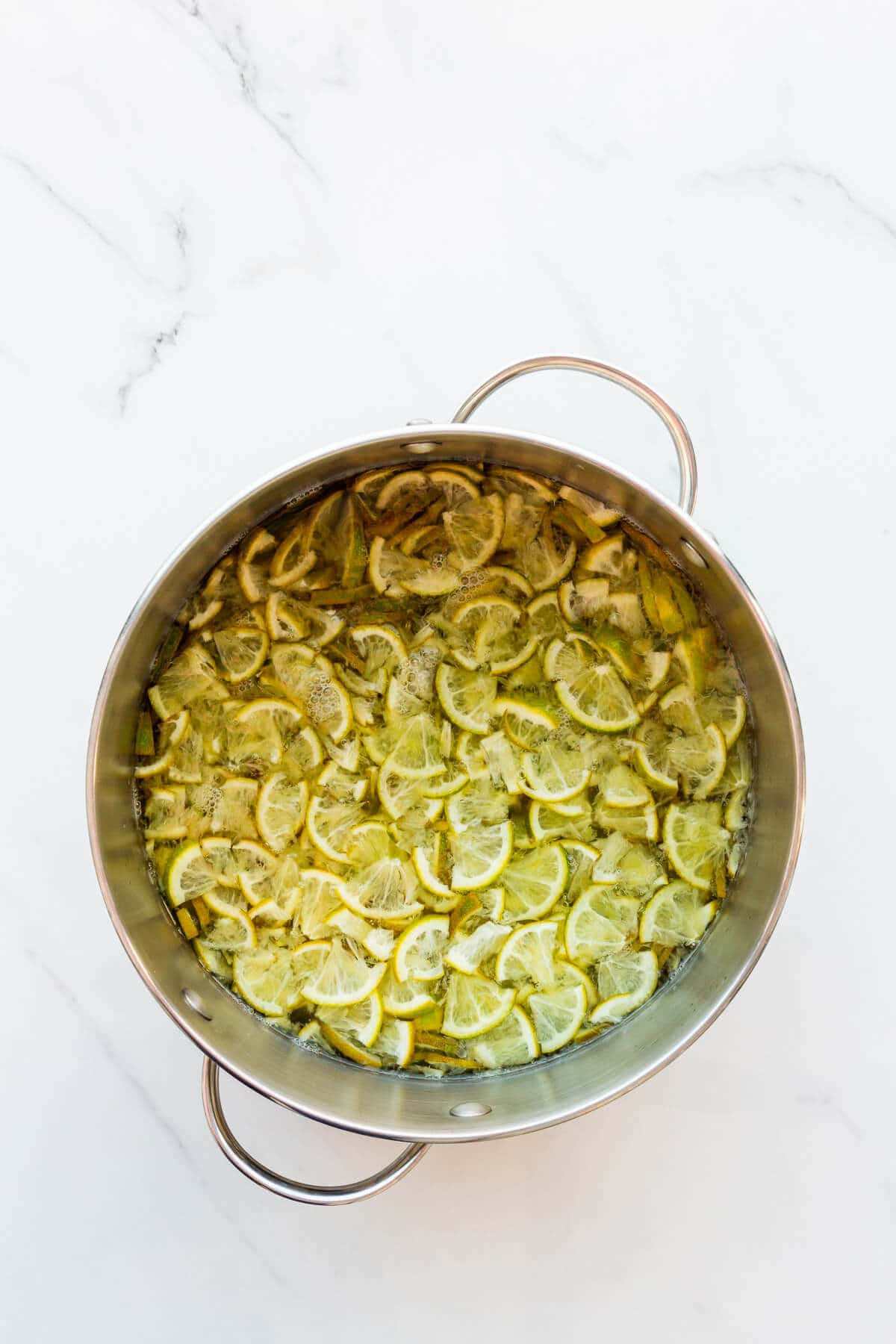
The method
For most marmalade recipes on this site, we use the whole fruit method, where you immerse the whole fruit in a large volume of cold water, and bring it to a boil, cooking for 1–2 hours, until the fruit is very tender, and so soft that you could use your hands to tear the fruit apart easily. With this method, you slice the whole soft fruit, so the cut of the peel can be quite rustic and more coarse, less "refined" than you might want. I used this method to make classic orange marmalade, grapefruit marmalade, and even three-fruit marmalade.
If you want a finer-cut marmalade, start with sliced citrus fruit. With this method we are still using the whole fruit, meaning peel, pith, flesh, and all, but we are starting the process with sliced citrus instead of the whole fruit. This is the method we are using to make this lime marmalade.
The sliced citrus is brought to a boil in lots of water, and it's simmered for two hours, until very soft and tender.
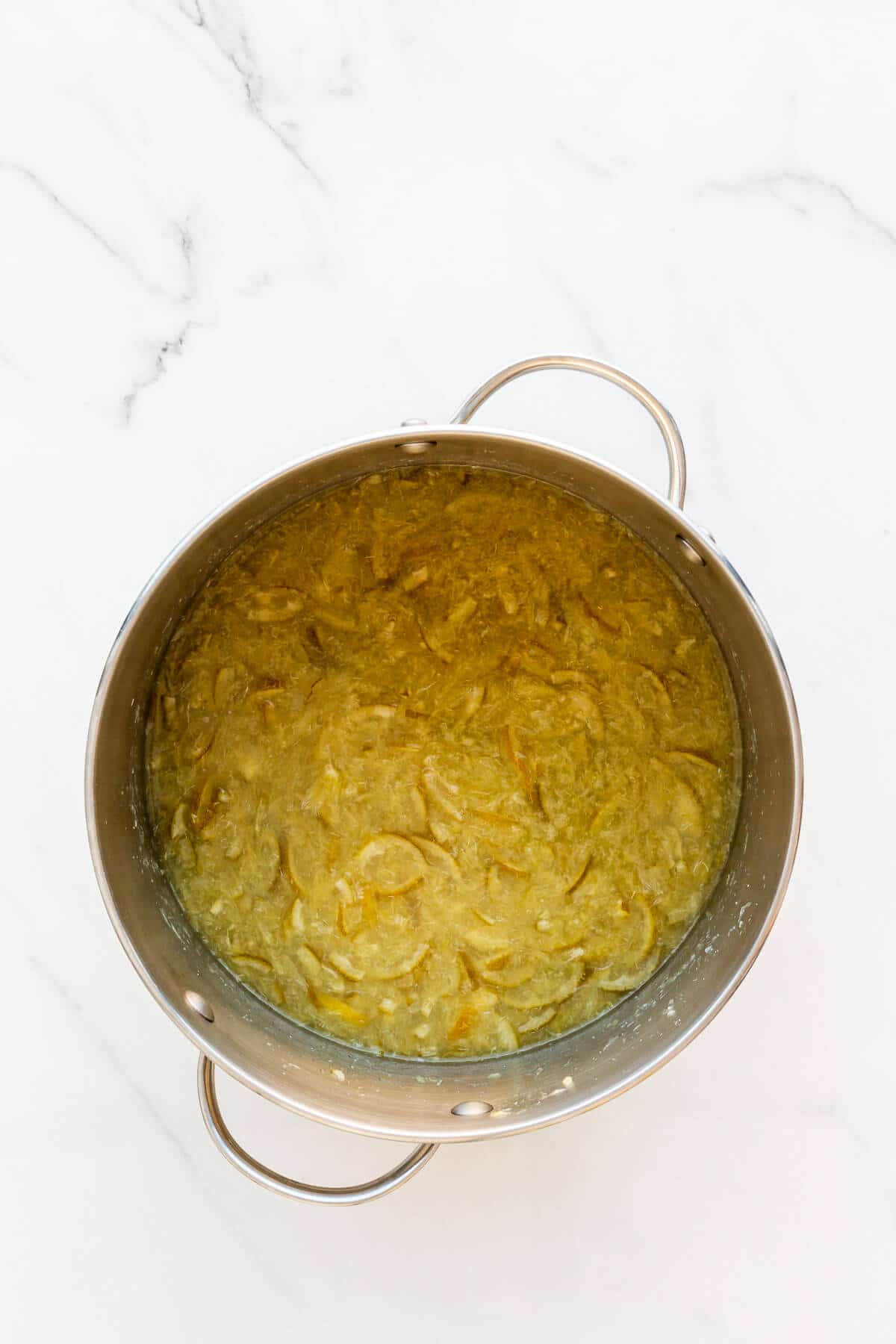
Avoiding chewy peel
One of the big problems with making marmalade is that the peel can end up hard and chewy if you don't handle the fruit correctly. To avoid this, you have to boil the whole fruit (or sliced fruit in this case, or sliced peel) for over 1 hour, until the peel is extremely tender and so soft you can tear the fruit without using any force.
Whole citrus fruit should be so soft you can poke the handle of a wooden spoon or even your thumb through the fruit without any effort. One visual cue for knowing how long to boil sliced citrus is to observe the pith (the white part of the peel). The pith should no longer be opaque and completely translucent. You should see no patches of white from the pith. If any remain, the peel will be chewy.
If you find your water has evaporated before the sliced fruit has cooked long enough, add more water. This will give the citrus peel more time time to cook and then, all you have to do is boil it down again to evaporate off the excess water.
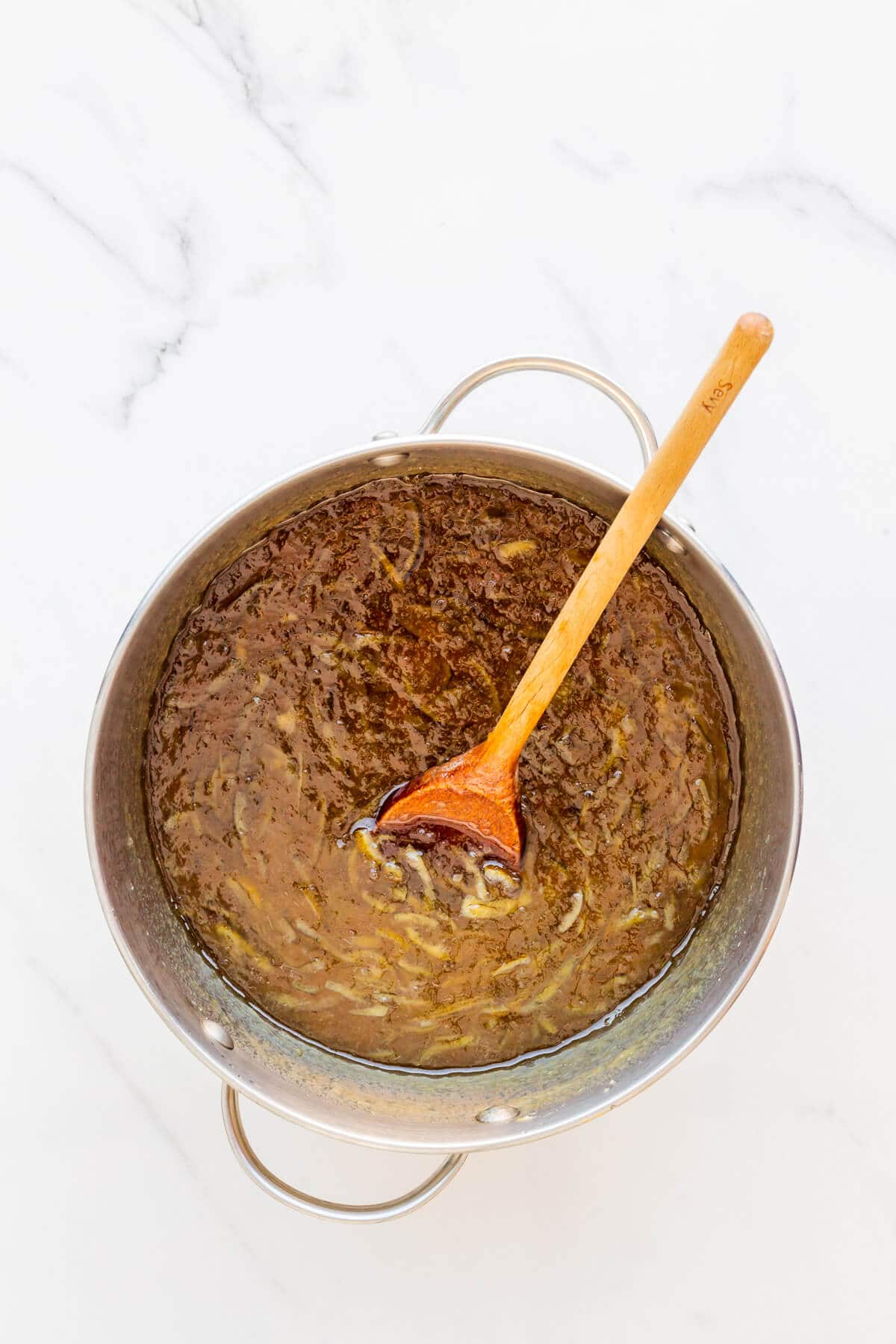
For this recipe, you do not need to remove the pith of the fruit from the peel, but you do need to take the time to properly soften the sliced fruit before adding sugar and proceeding with marmalade-making. If you don't do this step correctly, the peel will be tough and the marmalade will be inedible unless you strain out the toughened pieces of peel.
How to tell when the marmalade has boiled enough
Once you've added the sugar and the lemon juice, it's time to cook the marmalade. There are many ways to determine if you have hit the marmalade setting point:
- watch the temperature: use a digital thermometer to monitor the evolution of the temperature as you boil the mixture of citrus, sugar, and lemon juice. The setting point for marmalade is 104–105 ºC (220 ºF).
- watch the bubbles: early in the cooking process, the bubbles form and pop fast, whereas when you've hit the setting point, the bubbles are more stable, resembling blinking fish eyes
- watch the texture: marmalade boiled to the setting point is viscous and will drop in thick sheets off a spatula or wooden spoon, as opposed to a more fluid liquid texture at the beginning.
- use a frozen plate to do the plate test: freeze a few side plates or saucers in the freezer for an hour, then place a dollop of the cooked, hot marmalade on the plate, and put it back in the freezer for 1 minute. Retrieve the plate and nudge the dollop with your fingertip: does it wrinkle and seem "set"?
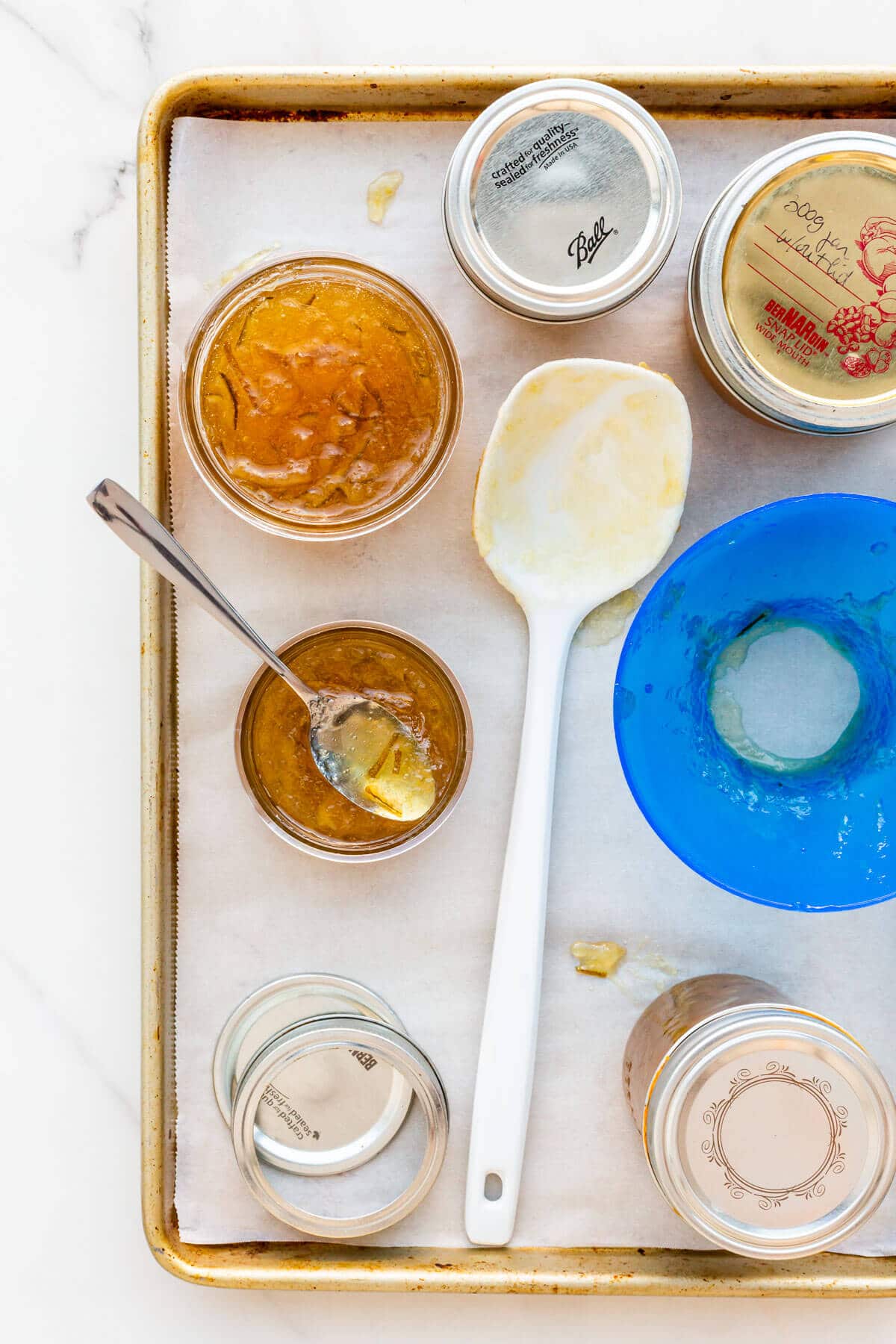
If you use a few of these tests and the marmalade passes inspection, you can transfer the mixture to jars to seal them. Remember for some of the more time-consuming tests, you should take the pot of marmalade off the heat or else you risk overcooking it! This is very important and if you overcook the marmalade, it will be dry and pasty, like a fruit candy or verging on a jelly or pâte de fruit, as opposed to spreadable marmalade.
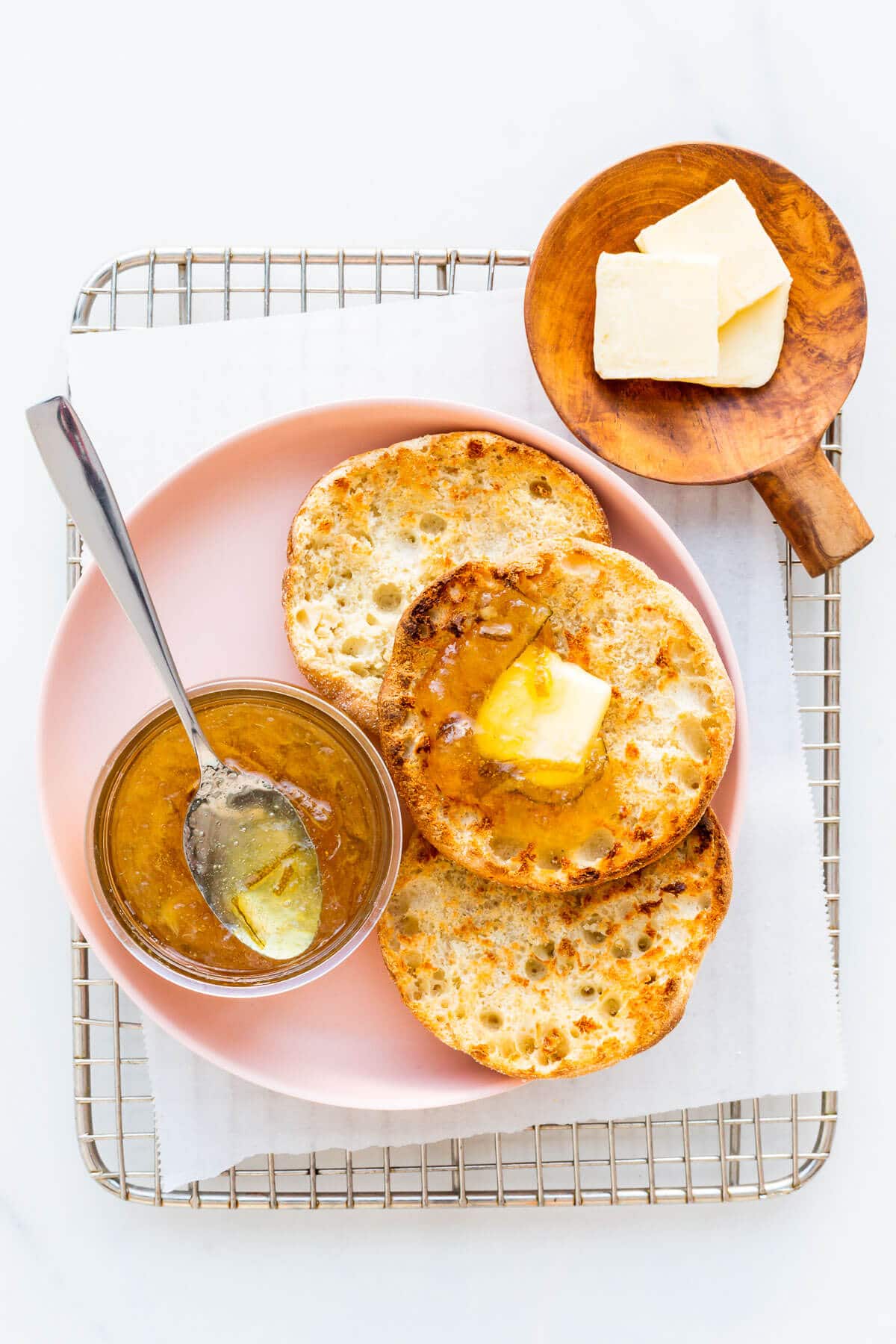
Methods for sealing jars of homemade preserves
There are two major ways to seal jars of homemade preserves, and a third which is considered unsafe today (sealing with paraffin). The two best methods to seal jars are quite different, but the end result is the same: you are creating a vacuum in the jar to preserve the contents and prevent air and microbes from getting in.
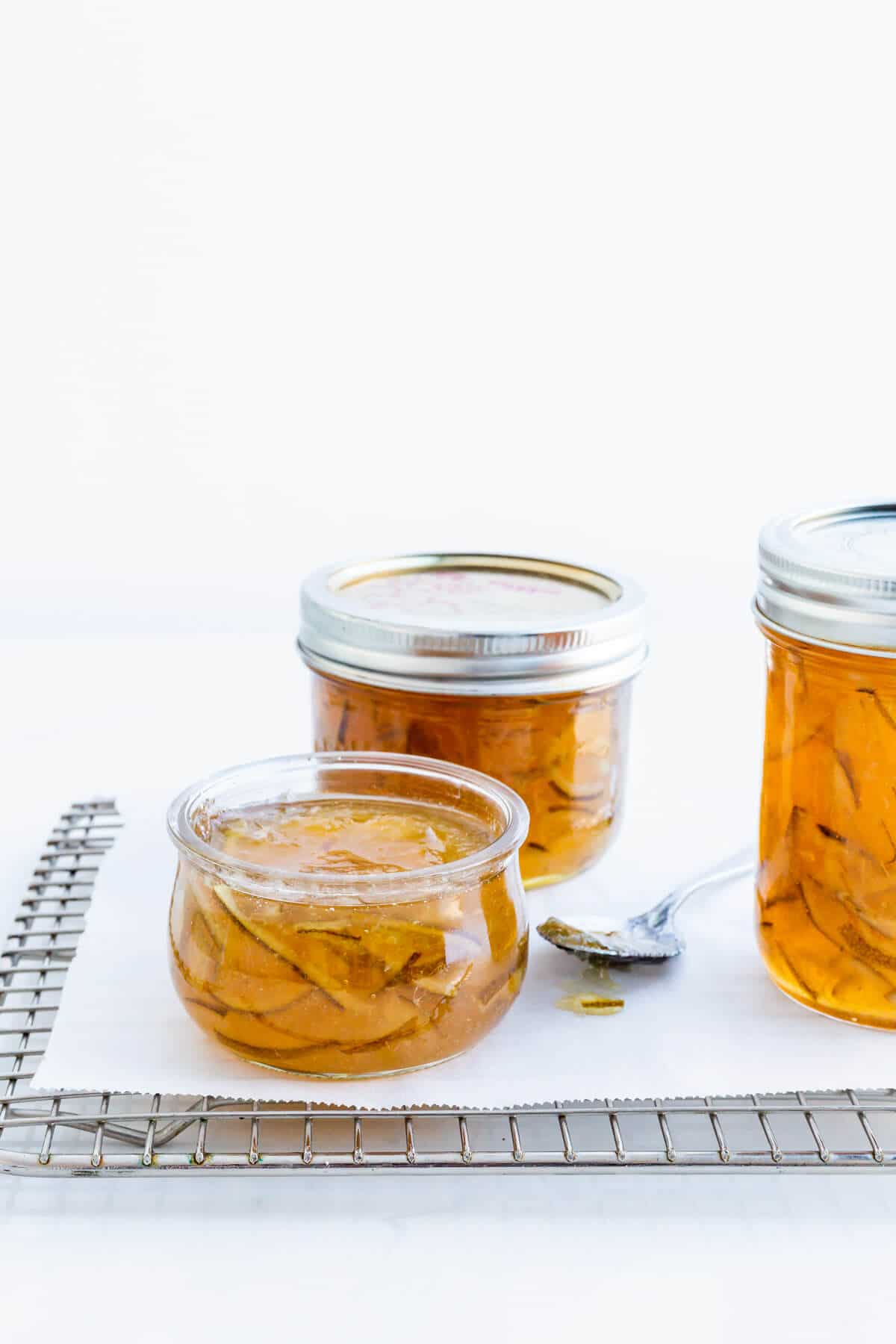
For both methods, start by transferring the marmalade to warm, clean jars, then close them with lids until fingertight, then:
- The quick and easy way: immediately invert the closed jars of hot marmalade, letting them sit upside down for 2 minutes. Flip the jars back upright, and let them stand for 24 hours undisturbed.
- The long way: bring a large canning pot to a boil, then carefully drop the jars into the boiling water bath so that they are immersed. Bring back up to a rolling boil and boil jars for 10 minutes. Carefully lift the jars out of the bath and let stand for 24 hours undisturbed
With both methods, the jar lid will likely make a popping sound, a good indicator that the contents are sealed. If you don't follow either of these methods, you will have to store the jars of marmalade in the fridge.
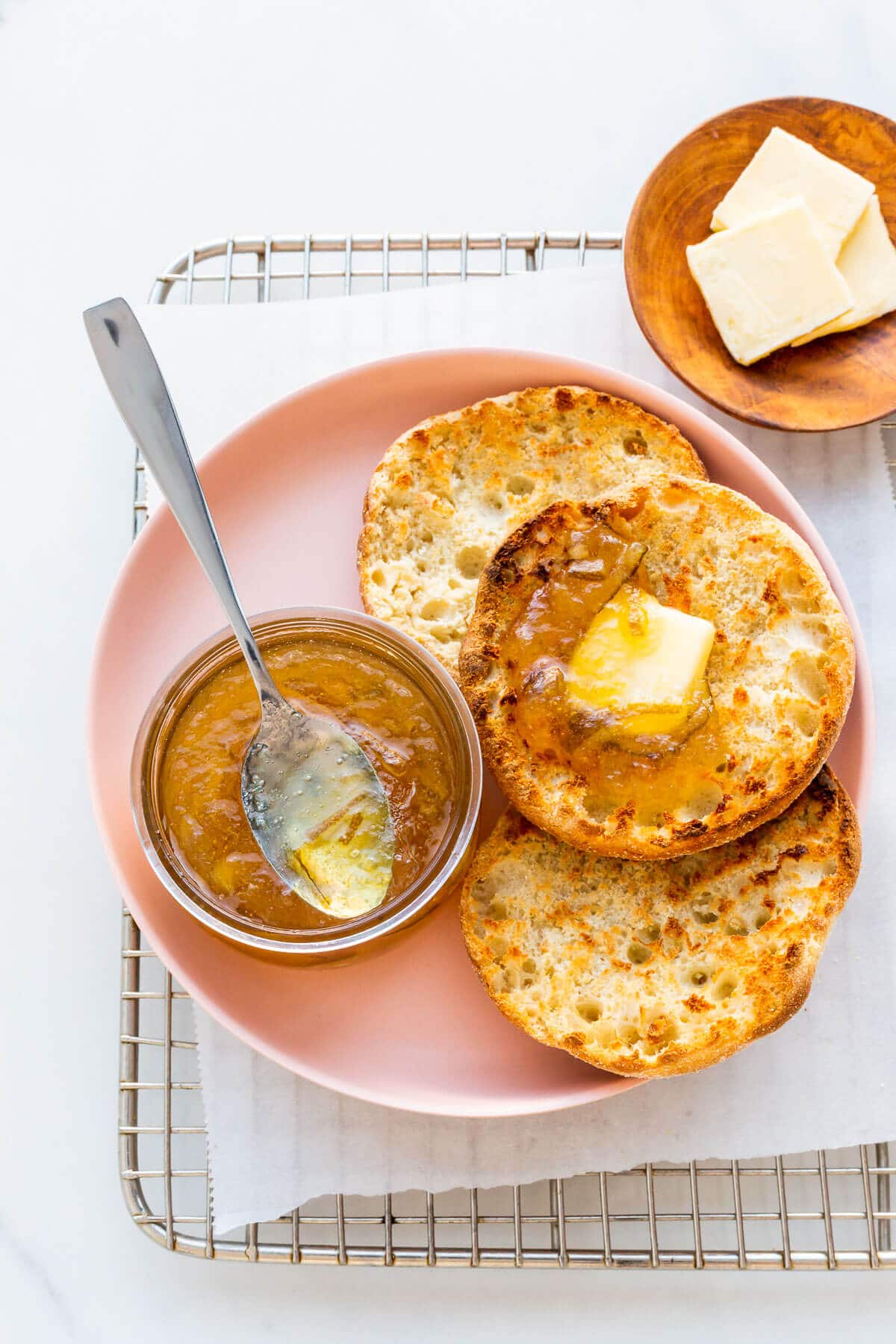
Storage
If the jars are properly sealed, you can store marmalade in a cool, dry place, away from the light for 1 year. After that, the marmalade will still be good, but you will notice the vibrant colour will change and the marmalade will become darker.
Store open jars of marmalade (or jars you have not sealed) in the refrigerator.
Frequently asked questions
Like other citrus fruit, limes have quite a bit of pectin. The pectin is located predominantly in the peel.
It's a common misconception that all the pectin of citrus fruit is in the seeds. In actual fact, commercial pectin is extracted from citrus fruit peel! Ditch the seeds when you are prepping the fruit, and your set will be just as perfect, as long as you use the right ratio of sugar to fruit and you boil the marmalade until you reach the marmalade setting point.
You do not need to add pectin or any special ingredients to achieve the perfect set. Citrus that are in season, ripe, but not too ripe, have a lot of pectin in them. No need to add more! Remember that pectin contributes to the set, but also the ratio of fruit to sugar, the cooking temperature, and the pH. Make sure to follow the recipe quantities closely to ensure success!
If you did not boil the marmalade for long enough, then your marmalade will have too much water and will be runny. Make sure to boil the mixture of fruit and sugar for several minutes, until the marmalade is thick, the bubbles look stable (like blinking fish eyes), a frozen plate test shows a dollop of marmalade wrinkles, and the temperature of the marmalade hits 104–105 °C (220 °F). Use several techniques to gauge if the marmalade has boiled enough to ensure the perfect set! Use a fast-reading digital thermometer like this one from Thermoworks.
If after 24 hours, you find your homemade marmalade is runny, you will have to transfer the marmalade back to a big pot and bring it back up to a boil and boil off the water. Boil to the setting point of 104–105 °C (220 °F) and check the set with a frozen plate test.
Once you boil the marmalade to the setting point, it's very important to take the time to let the pot of marmalade sit for several minutes before stirring again and ladling it into jars. The rest time gives the marmalade a couple of minutes to cool down and thicken, to better suspend the slices of peel in the marmalade.
📖 Recipe
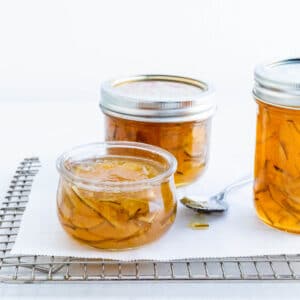
Lime Marmalade
Ingredients
- 650 grams limes this is roughly 8 limes
- 1.5 L water
- 1000 grams granulated sugar
- 60 mL fresh lemon juice
Instructions
- To prepare the limes, slice off the ends to discard them, then quarter the fruit and thinly slice. Transfer the sliced fruit to a big pot and add the cold water. Put the lid on the pot and let the sliced fruit soak for about 12 hours (overnight).
- After soaking for 12 hours, uncover the pot and place it on the stove. Turn the burner on to high heat and bring the mixture to a boil. Once at a boil, cover the pot (or partially cover) and reduce the heat to a slow simmer (medium–low or even low) and let the fruit slices simmer for 1.5 hours.
- Uncover the pot, and let the citrus continue to simmer for another 30 minutes. The water will slowly evaporate over this time and most importantly, the white pith of the lime peel will become completely translucent. The fruit slices will be very, very soft and tender. This Cuisinart pot from Amazon is a decent size for the job. The goal is to soften the pith (the white part of the peel) so that it is completely translucent. During this step, most of the water will evaporate and you will be left with about ½–⅓ the original volume. Do not try to speed up this step and do not boil the fruit too vigorously or else you risk the peel being chewy and hard!
- Once the fruit slices are very soft and the volume has reduced by almost two-thirds, turn off the heat and let the fruit sit for one hour before proceeding. This is to further ensure that all the fruit has softened sufficiently.
- Add the sugar and lemon juice to the pot with the softened citrus fruit. Bring the mixture back up to a boil over medium–high heat, and continue to cook, stirring occasionally with a wooden spoon or heatproof spatula (grab this spatula from Amazon), until you reach the marmalade setting point (104–105 ºC or 220 ºF)—use a fast-reading digital thermometer like this one from Thermoworks. You can also check the consistency by letting the marmalade drip off a spatula over the pot. It should fall in a thick sheet as opposed to a very fluid, loose droplets.
- When the marmalade reaches the set temperature, slide the pan off the heat, and let it cool for 2 minutes, then give it a good stir. This is to ensure that your canned marmalade will have an even dispersion of peel/fruit.
- Line a rimmed baking sheet with a large kitchen towel (these Nordic Ware sheet pans from Amazon are great). This will be the “cooling station” for the jars.
- Divide the mixture between 5 or 6 sterilized jars (I prefer wide-mouth mason jars like these Ball jars on Amazon), leaving a headspace of ¼ inch. If the last jar has a larger headspace, that will be your jar to enjoy right away, storing it in the fridge.
- Wipe the rims of all the jars with a lightly moistened paper towel. Top each of the jars with a sterilized lid, and tighten the band until it is finger tight. The Ball canning kit on Amazon is key for this step and the next! Get it on Amazon.
- Flip the closed jars upside down and let them stand, inverted, for 2 minutes, before flipping back upright. You will hear a popping sound soon after you've flipped the jars, a good sign that the vacuum seal is created.
- Let the jars cool, untouched, for 24 hours before putting them away.

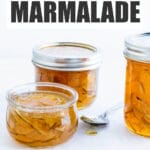
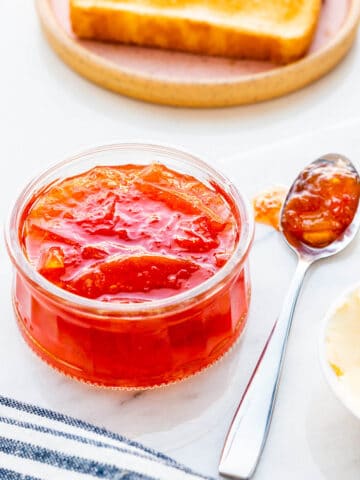
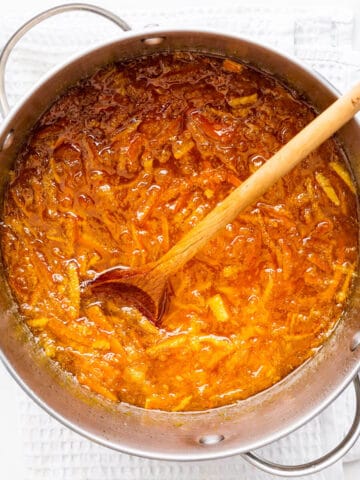
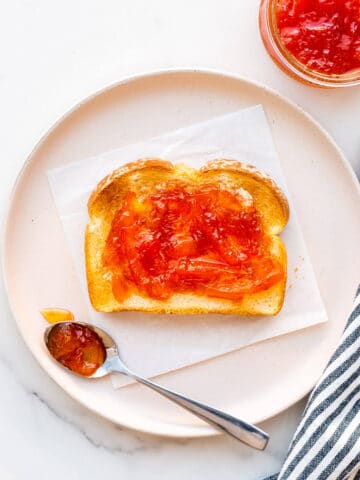
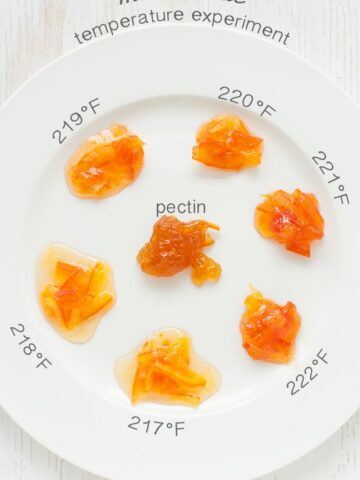
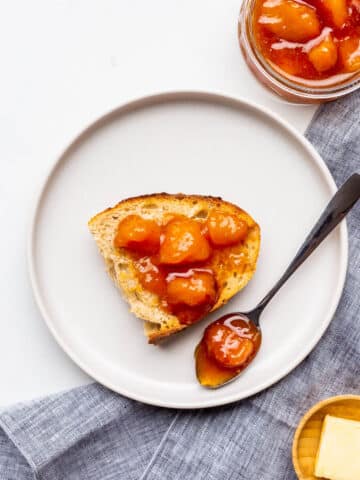
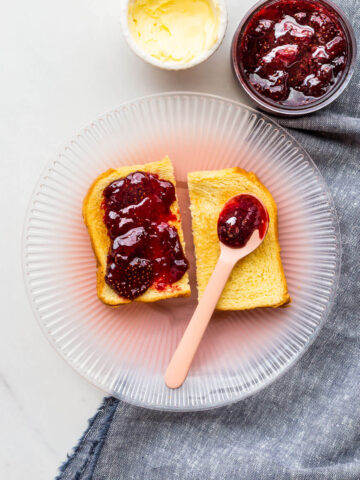
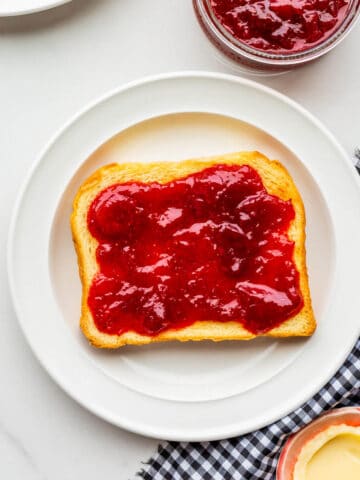
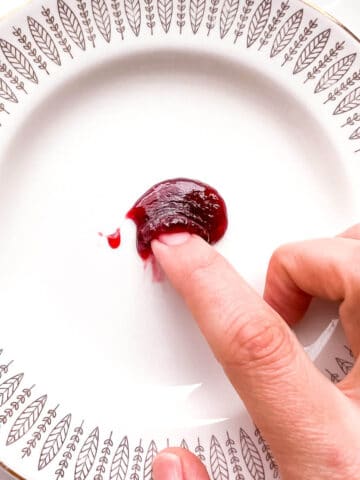
Susan says
What is the role of lemon juice? I'm sure there's a good reason but I'm so tempted to add lime juice!
Janice Lawandi says
Great question! Yes, you can definitely use lime juice instead. I mostly use lemon juice in all my jams and marmalades because I hate juicing limes 😉
Angela says
Hi,
Can you minimize the soaking time ?
I wanted to make it tonight after soaking for 7 hours.
Love this recipe. Made it with my Bears lime and gave it for Xmas gifts.
Thank You
Janice Lawandi says
Hi Angela,
I'm so glad you love this recipe! I think that reducing the soaking time would be fine, but reducing the first stage of boiling the soaked fruit would not work (which I tried twice and ended up with chewy peel in my marmalade both times). And given you've reduced the soaking time, if anything, you may want to give the boiling fruit even more time to soften before adding the sugar. Hope that helps and let me know how it goes!
Desiree Gray says
Hi there, I followed this recipe to the T but found it too bitter! Can you advise?
Janice Lawandi says
Hi Desiree,
Marmalade is quite bitter because of the peel of the citrus fruit. It's pretty much inevitable as it is a bittersweet spread. How did you eat it? I find eating it on toast with salted butter (yes, salted) helps balance the bitterness of the marmalade. Salt and fat are key. Sometimes I even sprinkle a little flaky sea salt on the marmalade. Hope that helps!
Some go through the process of removing the pith to supposedly reduce the bitterness of the peel. I have never tried this so I am not sure if it really impacts the bitterness or not. Hope that helps!
Gwen Hindhaugh says
I love lime marmalade recipe, made it twice with success. Just wondering about raspberry jam - do you use same amount of sugar as fruit? Gwen Hindhaugh Australia.
Janice Lawandi says
Hi Gwen, for fruit jams, I usually do 2 parts fruit to 1 part sugar by weight, so 1000 grams of fruit for 500 grams of sugar. I haven't made raspberry jam in years, but I'd stick to that ratio if I did. Hope that helps!
Amanda Moloney says
Just made this, started off with the double recipe due to my limes and without realising at some point went back to the single when it came to the sugar LOL. Still turned out great just took a lot longer time of boiling it to set point. Tastes amazing, even the hubby and kids loved it.
Janice Lawandi says
Hi Amanda, I'm so glad it worked out! I actually included more sugar in the lime marmalade than, say, the orange marmalade so I'm not surprised it still worked, though as you noted: less sugar can mean a longer boiling time to reach the set point. I'm so glad you enjoyed this recipe!
Albert L J Hall says
There's some contoversy about how much sugar to usxe in Jams,Preserves and Marmalades. My own 'rule of thumb is 50/50 Fruit to Sugar. Bythe way the difference between JAMS [US 'JELLIES'] and PRESERVES/CONSERVES is that usually the cheaper Jams'/Jellies have a higher SUGAR to FRUIT ratio [even up to 70% sugar] and the FRUIT is PULPED. Conserves Preserves generally speaking retain either WHOLE of COARSE chopped Fuits and less sugar The more expensive ones as little a between 35 and 40%.
Gwen Hindhaugh says
Hi., I've made this recipe twice, great success. Love the recipe content, everything simple and it works a treat. Thank you from Australia.
Kate says
Just made 6 jars today using double the recipe because I had so many limes and lemons. Followed your recipe to the T and probably boiled it longer than stated----same for soaking, because of not watching time well enough doing house work.. Because it was a wee bit bitter, I grates a 4cm piece of ginger into the mix, making sure I chopped it up well before adding. The result was scrumptious. Hubby was in love with it too. Can't wait for Brekky toast and Lime Marmalade in the morning...its still warm in the jars. Thankyou for a great recipe
David says
That is a lot of sugar, 1000g for 650g fruit. Surely it can be normalized to approximately an even ratio?
Janice says
Hi David,
Great question! I do a 1:1 ratio by weight of fruit to sugar for orange marmalade, but I add more sugar when I make lime or lemon marmalade. I prefer it this way because the fruit is more sour. I think as long as you at least have a 1:1 ratio of fruit to sugar by weight, your set will be fine. And with the limes, I can't stress enough how important the first stage of boiling the sliced fruit in water is to soften the peel. I made so many batches of lime marmalade where I thought I'd softened the fruit enough, but hadn't and it ended up tough. The longer the better for that first step of boiling in water!
Helen says
Hi Janice
I have tried this marmalade and it is divine! But I wanted to give it a more appealing look so I used food colouring. I was expecting a nice greenish colour but instead ended up with a mix of yellowish-green colour. Not at all appealing in fact. Am I doing something wrong? Or is this the colour one obtains in adding green food colouring to a yellow mixture? Some lime marmalade in the shops are light green in colour. How can I obtain this?
Janice says
Hi Helen, perhaps blue would be the answer? My lime marmalade appeared golden yellow and sometimes green-ish depending on the light and the angle and without dying it. I haven't tested dying, but I've seen on labels green dye listed. Did you use gel food colours? They will likely work better than grocery store water-based fluid food colours. Hope that helps!